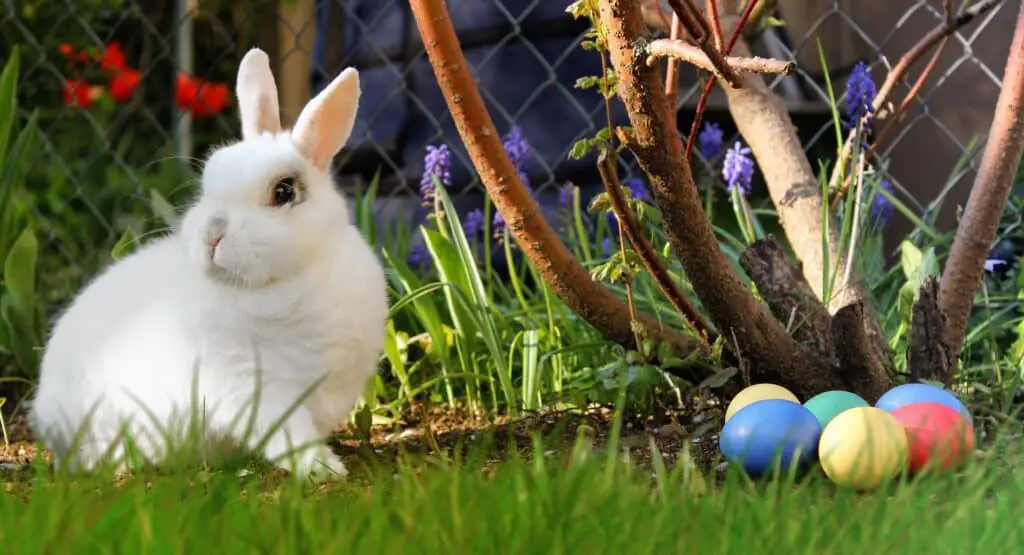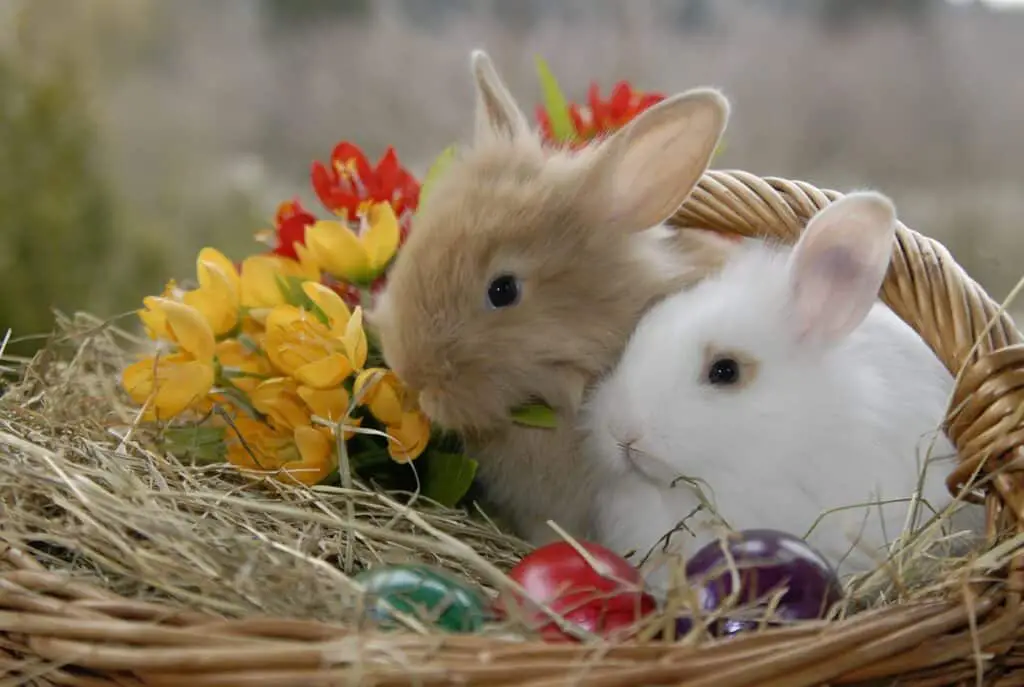
Do rabbits lay eggs? This question might sound a little crazy to some people, but this confusion makes a lot of sense to many, thanks to the Easter bunny and Easter eggs.
Rabbits do not lay eggs, contrary to popular myth. Rabbits are placental mammals and develop as embryos inside their mother’s uterus for an average of 31 days before birth. Since eggs are historical symbols of rebirth, the rabbit’s prodigious fertility is likely the basis for this egg-laying legend.
This is not the only “crazy” belief out there. in a survey conducted by The Innovation Center for U.S. Dairy, and heard on NPR, more than 1,000 adults were polled and discovered 48% of Americans aren’t sure where chocolate milk comes from and 7% thought chocolate milk only comes from brown cows.
I would say this is even crazier than the idea that rabbits come from eggs!!
But do not feel bad, this is a very common topic that receives its share of chatter on the internet. The main reason for the confusion behind rabbits laying eggs derives from the Christian holiday Easter and a bunny rabbit delivering Easter eggs to children around the world.
This article will look deeper into the origins of the Easter egg, and the Easter bunny, to fully understand this misconception. Additionally, we will explore some other mammals that actually do lay eggs and we’ll rake a deep dive into how rabbits give birth, so keep reading.
Origin Of Easter’s Rabbit Egg-laying Myth

To begin, we should take a look at the reason why rabbits laying eggs is such a common misconception, where it comes from, and its meaning.
The modern myth of rabbits laying eggs was likely the work of 18th-century German Lutheran immigrants who settled in Pennsylvania. These early immigrants brought with them their unique brand of Easter traditions when they formed the American Pennsylvanian Dutch Community.
These early Easter traditions were very similar to Christmas, Christmas Eve, and its protagonist, Santa Claus.
The night before Easter, children in the Dutch community would leave hats in a secret place as a “nest” for the Easter bunny, known as Oschter Haws (Easter Hare), hoping to be deemed as good girls and boys.
Boys would leave out caps and girls would leave bonnets, with the hopes that, while they slept, the Oschter Haws (Easter Hare), an egg-laying rabbit, would leave them treats.
If the children were deemed bad or less worthy, they would receive rabbit poop in their hats.
The true origin of the egg-laying rabbit may be lost in time. Still, many historians believe this tradition originated in the Festival of Ēostre or Ostara, which was a feast to honor the Spring Equinox, rebirth, and fertility.
With the main focus being birth and fertility, it makes sense the icons of this celebration were eggs and rabbits. Eggs were thought of as a symbol of a promise of rebirth and fertility, and rabbits are one of the most fertile animals.
In the Christian culture, the egg has a totally different meaning. Christians use the eggs as a symbol of the empty tomb of Jesus after the resurrection. Some even paint the eggs red, which symbolizes the blood of Christ, shed at the moment of his crucifixion.
But the decorated and colorful eggs are not something recent, they could even be older than the egg-laying rabbit.
According to historical records, decorated eggs samples have been found at some ruins in Egypt, Greece, Persia, and Rome, dating back to the year 3000 BC. Many Ancient civilizations used decorated eggs in spring celebrations.
Today, this Easter tradition has evolved, and most of the eggs are not actual eggs but eggs made of chocolate, sometimes also containing other treats inside. Additionally, the way kids collect eggs has changed over time resulting in egg hunts and other games allowing children to win the eggs.
If Not By Egg, How Do Rabbits Give Birth?
To fully understand how rabbits deliver their baby bunnies, one must know when female and male rabbits are fertile, pregnant, and the process of labor.
Female rabbits become fertile and can become pregnant as soon as they turn 12 weeks old, and remains so until 4 years old for females. As for males, They are able to sire offspring up until 7 years of age. In addition, female rabbits can become pregnant at any time of the year.
Once the female rabbit, or doe, becomes pregnant, there are a few behaviors that can let you know baby bunnies are on the way.
The behaviors that tell you your rabbit is pregnant include:
- The doe will build a nest where she will deliver and house their babies.
- Rabbits begin to pull their fur out to create a blanket to keep the baby bunnies warm.
- Female rabbits will become more aggressive and ofrten growl in defense of the nest.
While your rabbit is pregnant, she will need to drink ample clean water and eat healthy food including leafy greens, alfalfa hay, and rabbit pellets.
Be sure to provide a relaxed and private place such as a nesting box to keep the doe and her offspring comfortable.
The pregnancy in rabbits lasts around 31 days. The act of giving birth takes about 15 minutes and is called kindling, in which the mother can deliver 12 or more babies. Kindling tends to occur in the first hours of the day, and most rabbits will not need human assistance as it is an instinctive process.
Once the female rabbit, or doe, has ensured the babies are alive and healthy, you should try to leave the kits alone for the first few days to avoid the mother feeling stressed out, which can cause her to stop feeding her babies.
Baby bunnies, called kits, are hairless, blind, and deaf; and it takes ten days for them to start developing properly. The Kits get nursed twice a day and nursing lasts around 5 minutes as the mother’s milk is extremely rich.
To be fully weaned from their mothers, kits need to be around 4 to 6 weeks of age. During all this time, the mother should remain separated from the male rabbit, as she can become pregnant just hours after giving birth.
Do Any Mammals Lay Eggs?
Although rabbits do not lay eggs, this does not rule out the possibility of other mammals doing so. There are just two mammals that can lay eggs in the world, and these belong to the unique third group of animals called Monotreme mammals.
Mammals that lay eggs include:
- The echidna, also known as the spiny anteater. This one lays the eggs in a pouch where they will hatch.
- The platypus. These lay the eggs in an underground nest.
In some ways, monotremes are more similar to reptiles than mammals.
Besides laying eggs, a monotreme’s average body temperature of about 31 °C (88 °F) is considerably lower than most other mammals. In fact, with marsupials raging 35 °C (95 °F) and 37 °C (99 °F) for placental mammals, a monotremes body temperature most resembles that of reptiles than other mammals.
Final Words

To wrap this up in just a few words, we can say rabbits do not lay eggs. Still, the rabbit and the egg have something in common. They both symbolize new life and fertility, which was why they were used in ancient festivals across the world celebrating the beginning of spring, a new life, and fertility.
Rabbits symbolize fertility thanks to their prodigious breeding. Female rabbits can become pregnant at the age of 12 weeks, and until they are 4 years old, they can get pregnant any time of the year. Pregnancy in rabbits lasts about 31 days when they give birth to approximately 12 kits. After a few hours of giving birth, female rabbits can become pregnant again.
So, now you know, if you are considering a rabbit as a pet but do not want to end up with a vast family tree, try to keep females and males separate from each other.
